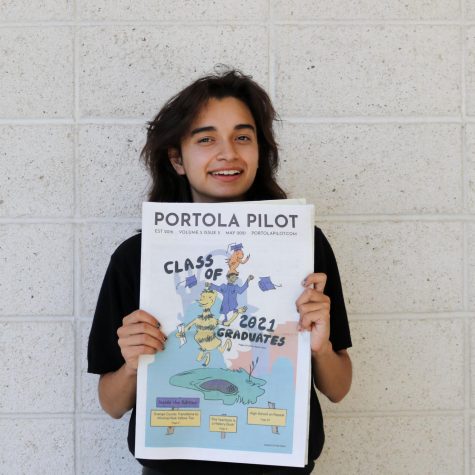Meet Tyrolean
According to instrumental music teacher Desmond Stevens, Portola High is the only school in IUSD to have its very own street piano but the music program would be more than happy to take any unwanted pianos off of another person’s hands. Though instrumental music teacher Desmond Stevens does not play the piano by the theater, claiming he has “spatulas for hands,” he said he saw the value of leaving an instrument outside for the public. “We know that our student body has a lot of rich musical experience, whether or not they have the time in classes, so we wanted that opportunity for [the piano] to be open to anybody at any time,” Stevens said.
The vivacious spring of a ragtime. The sentimental (if not overplayed) lull of “River Flows in You.” The resounding motif of a structured baroque solo.
Each day, students are greeted with piano performances as they walk around the VAPA quad. Though the music and musicians invariably change, Tyrolean remains constant.
As in, the beloved Tyrolean street piano that stands staunch beside the music room.
Instrumental music teacher Desmond Stevens first brought Tyrolean to campus four years ago after it was donated by a former co-worker’s mother, according to Stevens.
While the piano was originally placed in the black box theater for the first year, Stevens and choir director Adrian Rangel-Sanchez agreed to move it outside when they realized that the old instrument could not be tuned for rehearsals and was better suited as a street piano.
This decision was partly inspired by the first time Rangel-Sanchez and Stevens met at a music education conference in Denver. Street pianos were scattered throughout the city, and at one point, Rangel-Sanchez stopped to play a quick tune while Stevens recorded. The subsequent video was then used to introduce Rangel-Sanchez to Portola High.
Tyrolean now seats students of varying musical proficiency every break or office hours, whether it is with
the familiar melody of “Twinkle Twinkle Little Star” or the upbeat swing jazz of Mussorgsky’s “Promenade Pictures at an Exhibition.”
“The thing about the band room area is that it’s always lively during breaks, snack, office hour, lunch,” senior Mandy Chokry said. “There’s always someone playing some instrument, and it’s just this buzz of different musical expressions.”
At times, students crowd around the piano to admire in silence and applaud in appreciation; other times, the sole tune harmonizes with the chatter, becoming the ambience of the music quad.
“It’s not like you feel like you’re performing for a big audience or trying to steal attention,” Rangel-Sanchez said. “It’s just there so that when you’re walking by with your friends, if it’s free, you can just noodle around, play a couple songs or play something fun… So it’s just to help create a community of music and to have an opportunity for students to explore.”
After years of weather exposure, Tyrolean’s condition has declined, its paint flaking and its keys growing sticky with use.
Though Tyrolean is currently sporting a plain black coat, in the past, Rangel-Sanchez and Stevens spruced up its distressed appearance by allowing students to draw over Tyrolean with chalk. For years, the instrument was adorned with music-related illustrations, scrawled names of potential pieces to perform and a list of pieces that were jokingly banned from being played (like “Chopsticks” or “Megalovania”).
As for how the music sounds? Dissonant. But this has nothing to do with the skill level of the players and everything to do with Tyrolean having not been tuned in four years. However, the “honky-tonky” tenor of Tyrolean, as Rangel-Sanchez would say, is fitting for certain styles such as jazz and ragtime.
“In all honesty, I really hate that piano, but in an affectionate way because it’s really out of tune and really hard to play. The keys are chipped and dusty, and there’s this one key that doesn’t even make a sound,” Chokry said. “But I do agree that it does make things a bit more charming. You know, kind of like finding the perfection in imperfection.”
Your donation will support the student journalists of Portola High School. Your contribution will allow us to purchase equipment and cover our annual website hosting costs.

Charlotte Cao is the Features Editor for her third and, unfortunately, final year on the Pilot. Whether it be through the co-writing of stories or during...

Grace Baek is the assistant Sports Editor for her second and final year on the Pilot. She is looking forward to getting to know the new staff members and...

Nate Taylor is the 2021-22 front page editor and photo editor. He is ready to improve his design skills and create memorable Portola Pilot front covers....



![According to instrumental music teacher Desmond Stevens, Portola High is the only school in IUSD to have its very own street piano but the music program would be more than happy to take any unwanted pianos off of another person’s hands.
Though instrumental music teacher Desmond Stevens does not play the piano by the theater, claiming he has “spatulas for hands,” he said he saw the value of leaving an instrument outside for the public. “We know that our student body has a lot of rich musical experience, whether or not they have the time in classes, so we wanted that opportunity for [the piano] to be open to anybody at any time,” Stevens said.](https://portolapilot.com/wp-content/uploads/2021/11/IMG_8356-900x600.jpg)
